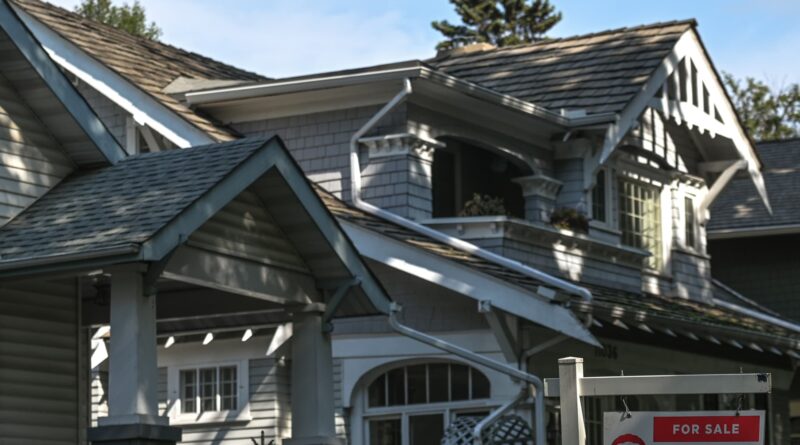Will Individuals ever be capable to afford to purchase a house once more?
Nurphoto | Nurphoto | Getty Photographs
As mortgage rates reached a 23-year high final week, the cry went off throughout markets and social media: Is housing affordability lifeless? Has a model of the American dream — house possession, youngsters, yard barbecues — died with it?
The query is sharp as a result of housing affordability has dropped by almost half because the ultra-low rate of interest days of 2021, in keeping with the Nationwide Affiliation of Realtors.
The median household was already $9,000 quick in August of the revenue wanted to purchase the median present house, the affiliation says, and the latest surge in charges since has moved one other 5 million U.S. households under the qualification normal for a $400,000 mortgage, in keeping with John Burns Actual Property Consulting. At 3% mortgage charges, 50 million households might get a mortgage that dimension. Now it is 22 million.
Whereas an easing in treasury bond yields this week has introduced the 30-year fastened mortgage again a shade under 8%, there isn’t any fast repair.
The qualifying yearly revenue for a median-priced home in 2020 was $49,680. Now it is greater than $107,000, in keeping with the NAR. Redfin puts the figure at $114,627.
“[These are] beautiful numbers that render home affordability much more difficult for too many American households, particularly these seeking to purchase their first house,” bond-market maven Mohamed El-Erian, an advisor to Allianz amongst many different roles, posted on X.
“It is a very worrisome growth for America,” NAR chief economist Lawrence Yun mentioned.
Affordability is dependent upon three massive numbers, in keeping with Yun — household revenue, the value of the home, and the mortgage fee. With incomes rising since 2019, the larger difficulty is rates of interest. After they have been low, they papered over a surge in housing costs that started in late 2020, helped by individuals relocating to areas like Florida, Austin, Texas, and Boise, Idaho, to work of their previous cities from their new houses. Now, the surge in charges is crushing affordability whilst incomes rise sharply and housing costs largely cling on to the large features they generated throughout Covid.
“On the present 8% mortgage fee, mortgage cost[s] are 38% of median revenue,” Moody’s Analytics chief economist Mark Zandi mentioned. “The mortgage fee has to fall to five.5%, or the median priced house has to fall by 22%, or the median revenue has to extend by 28%, or some mixture of all three variables.”
On the identical time, demand for adjustable-rate mortgages has spiked to its highest stage in a yr amid the broader slowdown in mortgage functions.
What wants to vary to make housing reasonably priced once more
All three indicators face a troublesome highway again to “regular,” and regular is a good distance from right here. Just a few numbers illustrate why.
The Nationwide Affiliation of Realtors measures affordability via its 34-year previous Housing Affordability Index, or HAI. It calculates how a lot revenue the median household has to should afford the median present house, which, proper now, prices about $413,000, in keeping with NAR. If the index equals 100, it means the median household has sufficient revenue to purchase that home with a 20% down cost. The index assumes the household desires to pay 25% of its revenue towards principal and curiosity.
The long-term common of the HAI is 138.1, that means that, usually, the median household has a 38% cushion. Its all-time excessive was 213 in 2013, after the housing bust and 2008 monetary disaster.
Proper now, that index stands at 88.7.
Just a few eventualities utilizing NAR information assist illustrate how far affordability is from the typical between 1989 and 2019, and what can be required to push it again right into a extra typical vary because the nationwide common for the 30-year ticked decrease to 7.98% on Tuesday.
- If house costs are secure, charges have to fall to three.55% so as to be again to historic common.
- If costs develop 5%, charges have to fall to three.16%.
- If costs keep the identical however incomes improve 5%, charges have to fall to three.95%
- A mortgage fee that stays round 8% means median house costs have to fall by 35%, to $265,000.
- If charges keep at 8% and costs at present ranges, revenue wants to extend by 63%.
However these numbers understate the problem of getting affordability again to the place Individuals are used to seeing it.
Getting again to the affordability individuals loved in the course of the hyper-low rates of interest of the pandemic would take much more: The HAI reached a yearly common of 169.9 that yr, a stage few suppose will come again any time quickly.
Affordability grew to become stretched partly as a result of house costs rose 38% since 2020, in keeping with the NAR, however extra vital was the bounce in common rates of interest from 3% in 2021 to as excessive as 8% final week. That is a 167% bounce, driving a $1,199 improve in month-to-month funds on a newly purchased home, per NAR.
Greater wages are a plus, however not sufficient
Rising incomes will assist, and median household incomes have climbed 16% to greater than $98,000 since 2020. However that is not almost sufficient to cowl the affordability hole with out devoting a better share of the family paychecks to the mortgage, mentioned Zandi.
Except for the uncooked numbers, the path of financial coverage will maintain incomes from fixing the housing downside, mentioned Doug Duncan, chief economist at Fannie Mae. The Federal Reserve has been elevating rates of interest exactly as a result of it thinks wages have been rising quick sufficient to strengthen post-Covid inflation, Duncan mentioned. Yr-over-year wage features slipped to three.4% in the newest job-market information, he mentioned, and the Fed would really like wage development to be decrease.
Downward stress on house costs would assist, but it surely doesn’t appear like they may decline by a lot. And even when house costs do the decline, that development will not be sustainable except America builds tens of millions of extra houses.
After costs surged from 2019 via early 2022, it was simple to imagine a giant value correction coming, but it surely hasn’t occurred. In most markets, costs have even begun to show up slightly bit. Based on the realtors’ affiliation, the median value of an present house dropped by greater than $35,000 in late 2022 however has risen by $45,000 since its low in January.
Not sufficient new housing in America
The largest purpose is that so few houses are up on the market that the legal guidelines of provide and demand aren’t working usually. Even with demand hit by affordability woes, patrons who’re on the market should compete for therefore few houses that costs have stayed near balanced.
“Boomers are doing what they mentioned they have been going to do. They’re growing old in place,” Duncan mentioned. “And Gen X is locked into 3% mortgages already. So it is as much as the builders.”
The builders are form of an issue, mentioned Redfin chief economist Daryl Fairweather. They have been boosting earnings this yr, and BlackRock’s exchange traded fund monitoring the business is up 41%, however Fairweather mentioned they’ve barely begun to deal with a long-term housing scarcity Freddie Mac estimated at 3.8 million houses earlier than the pandemic, a quantity that has seemingly grown since.
Builders have begun work on solely 692,000 new single-family houses this yr, and 1.1 million together with condominiums and flats, she mentioned. So it’s going to take almost 4 years to construct sufficient homes to rebuild provide, and that leaves out new family formation, she added. In the meantime, condo building has already begun to sluggish, and a few builders, although not all, are pulling again on mortgage buydowns and different techniques they’ve used to prop up demand. PulteGroup’s CEO instructed CNBC this week it has been shopping for down mortgages to an efficient fee of 5.75%.
New homes sales for September introduced on Wednesday got here in a lot larger than anticipated, up 12.3%, although that covers contracts signed in September when mortgages charges have been decrease than now.
There are causes to consider extra patrons might materialize. Duncan mentioned the millennial era is simply transferring into peak house shopping for years now, promising so as to add tens of millions of potential patrons to the market, with the largest annual start cohorts reaching the typical first-time buy age of 36 years round 2026. If charges do start to say no, Fairweather predicts that can deliver extra patrons again into the market, however inevitably push costs again up towards earlier peaks, which there had been indicators of earlier this yr when mortgage charges dipped to six% in early March.
“We want a few years extra constructing at this tempo, and we won’t maintain the demand due to excessive rates of interest,” Fairweather mentioned.
The Fed and the bond market are massive issues
There are two issues with mortgage charges proper now, economists say. One is a Fed that’s decided to not declare victory over inflation prematurely, and the opposite is a hypersensitive bond market that sees inflation in all places it appears, whilst the speed of value will increase all through the financial system has dropped markedly.
Mortgage charges are 2 share factors larger than in early March – regardless that trailing 12-month inflation, which larger rates of interest theoretically hedge towards, has dropped to as little as 3.1% from 6% in February. That is nonetheless above the Fed’s 2% goal for core inflation, however a measure of inflation excluding shelter prices — which the federal government says are up 7% in the last year regardless of declines or a lot smaller features in housing costs reported by personal sources — has been 2.1% or lower since Could.
The Fed has solely raised the federal funds fee by three-fourths of a degree since then, as a part of its “larger for longer” technique — sustaining larger rates of interest reasonably than aggressively including extra fee hikes from right here. The largest purpose mortgages have surged of late is the bond market, which pushed 10-year Treasury yields up by as a lot as 47%, for a full 1.6 share factors. On high of that, the standard unfold between 10-year treasuries and mortgages has widened to more than 3 percentage points — 1.5 to 2 factors is the standard vary.
“It is laborious to justify the runup in charges, so it would simply be volatility,” Fairweather mentioned.
Even so, few economists or merchants count on the Fed to push charges decrease to assist housing. The CME FedWatch tool, which relies on futures costs, predicts even when the central financial institution is completed, or a minimum of close to achieved with its fee hikes, it will not start to chop charges till subsequent March or Could, and solely modestly then. And spreads will seemingly stay extra-wide till short-term rates of interest drop under the charges on longer-term treasuries, Duncan mentioned.
It might take till 2026 to see a ‘regular’ actual property market
To get affordability again to a snug vary will take a mix of upper wages, decrease rates of interest and secure costs, economists say, and that mixture might take till 2026 or later to coalesce.
“The market is in a deep, deep freeze,” Zandi mentioned. “The one option to thaw it out is a mix of decrease costs, larger incomes and decrease charges.”
In some components of the nation, it will likely be even more durable, in keeping with NAR. Affordability is much more damaged in markets like New York and California than it’s nationally, and moderate-income markets like Phoenix and Tampa are as unaffordable now as components of California have been earlier this yr.
Till situations normalize, the market would be the area of small teams of individuals. Money patrons can have an excellent greater edge than usually. And, Yun says, if a purchaser is keen to maneuver to the Midwest, one of the best offers within the nation will be present in locations like Louisville, Indianapolis and Chicago, the place comparatively small fee cuts would push affordability close to long-term nationwide norms. In the meantime, it may be a slog throughout the nation.
“Mortgage charges is not going to return to three% – we’ll be fortunate if we get again to five,” Yun mentioned.






